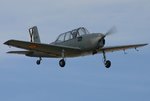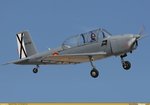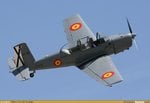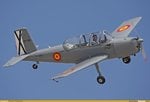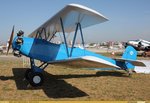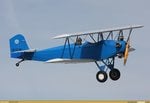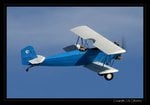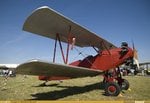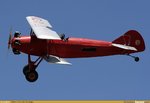- Thread starter
- #21
This aircraft is a military trainer designed in 1948 by Iberavia, a company later absorbed by Aeronautica Industrial, S.A (AISA). It was designed by a team of engineers leaded by Juan de Campo Aguilera for the Air Force, in order to replace their obsolete trainers Bücker Jungmann. On account of a lack of raw materials the aircraft was constructed mainly in wood, thus making it notoriously heavy. Moreover it was also underpowered fitted with the only available engines; the national produced ENMASA engines. As a result the I-115 had a disturbing tendency to quickly enter in a spin.
After two prototypes, it entered the production lines in 1956. About 200 units were produced in the AISA factory of Carabanchel, which is close to Cuatro Vientos. The E-9 (its Air Force name) never fulfilled the mission it was designed for; So that the E-9 flew for many years along the Bücker, the plane it was supposed to replace. It was mainly used for basic training in instrumental flight and as re-trainer of pilots. At least it fully replaced the HM1, which was also a Spanish airplane designed by Pedro Huarte Mendicoa. The HM1 'enjoyed' even a worse fame than the Garrapata. Pilots joked saying that HM stood for 'Hombre Muerto', Dead Man in Spanish.
This airplane never received an official name. It is believed that it was nicknamed 'Garrapata' by the Air Force cadets because of the annoying tendency to stick to the ground during take-off, like a 'garrapata' (tick in Spanish). In 1976 they were retired and most of them were handed over to flying clubs. There is one unit still flying in the flying club of Menorca and the FIO owns an airworthy Garrapata as well. The flying club of Sabadell used to operate three of them, but they were retired after two accidents.
After two prototypes, it entered the production lines in 1956. About 200 units were produced in the AISA factory of Carabanchel, which is close to Cuatro Vientos. The E-9 (its Air Force name) never fulfilled the mission it was designed for; So that the E-9 flew for many years along the Bücker, the plane it was supposed to replace. It was mainly used for basic training in instrumental flight and as re-trainer of pilots. At least it fully replaced the HM1, which was also a Spanish airplane designed by Pedro Huarte Mendicoa. The HM1 'enjoyed' even a worse fame than the Garrapata. Pilots joked saying that HM stood for 'Hombre Muerto', Dead Man in Spanish.
This airplane never received an official name. It is believed that it was nicknamed 'Garrapata' by the Air Force cadets because of the annoying tendency to stick to the ground during take-off, like a 'garrapata' (tick in Spanish). In 1976 they were retired and most of them were handed over to flying clubs. There is one unit still flying in the flying club of Menorca and the FIO owns an airworthy Garrapata as well. The flying club of Sabadell used to operate three of them, but they were retired after two accidents.

